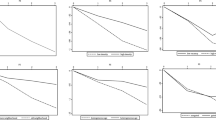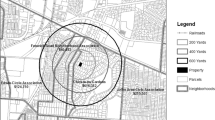Abstract
Foreclosures have negative impacts not just on homeowners, but also on neighboring properties. Due to the heterogeneous characteristics of the housing market, different neighborhoods can be impacted differently by foreclosures. This study focuses on the varying impacts of foreclosures on nearby property values across space. These results can provide insightful directions for decision makers to identify places in greatest need. A semi-parametric approach is applied to allow estimates varying over space. In Chicago, property values most impacted by foreclosures are in the south where the vacancy rate and crime occurrences are high and incomes are low. The spatial variation in impacts is wider for homes priced at the 10th quantile than at the 90th quantile. Moreover, the impacts are generally larger for home prices at the 10th quantile than at the 90th quantile, but the differences are not uniform across space.







Similar content being viewed by others
Notes
Challenges not only include limited grants for many qualified impacted areas, but also many practical perspectives need to be considered, such as occupancy status, property conditions, number of available real-estate-owned properties (REOs), and deadlines to locate the grants (Bak and Hewings 2017).
According to the first quarter of 2013 RealtyTrac’s U.S. Foreclosure Market Report: https://chicagoagentmagazine.com/2013/04/12/q1-realtytrac-foreclosure-report-a-mixed-bag/.
It is also often referred to as “geographically weighted regression” (e.g., Fotheringham et al. 2015; Yu 2006) or “locally weighted regression” (Cleveland and Devlin 1988). We are aware of the correlation among estimates across the space and between different coefficients. However, we intent to focus on the spatial trend of the estimates, but less focus on specific estimates for a particular location.
This adds some degree of parameterization.
See Loader (1999) for details on the target selection approach and interpolation options. Estimation in this paper is fulfilled by using command “qregcpar” in McSpatial package (McMillen 2013a) in R, which uses an adaptive decision tree approach for selecting the target locations and the modified Shepard algorithm for bivariate interpolation.
Since coefficients are estimated for different target locations, there could be more noise in the estimates for locations with few observations.
It is worth noting that the quantiles are conditional on explanatory variables rather than unconditional quantiles. In other words, the quantile comparison is location based: The 10th quantile level for the housing price in a wealthy neighborhood is different than the 10th quantile level in a southern neighborhood. When different results at different quantiles are compared, they are the quantile levels in each geographic location but not the quantile levels from the whole sample (e.g., 10th vs. 90th quantile within the same rich neighborhood and 10th vs. 90th quantile at the same poor location).
We choose this large window size rather than other smaller window sizes since the usage of small window size can generate observations with little variation. This causes the singular matrix problem in our analysis when solving quantile regression using “rq” command that is embedded in “quantreg” command.
Foreclosed properties are likely to sell for less (Coulson and Zabel 2013), due to potential stigma effects or other unobserved factors related to foreclosed properties.
The foreclosure risk score calculation also included the area price change and unemployment rate at the higher geographic level, such as the city or county. Thus, they do not account for any variation of foreclosure risk within the geographic scope of our study.
An additional robustness check controlling for the spatial autocorrelation within census tract is added in “Appendix B”.
Following Gerardi et al. (2015), we use a mix of both flow and stock measurement. “Active” foreclosures are the stock measurement of foreclosures (between filing and auction), while “Auctions in the past 0–12 months” is the flow measurement. Alternative ways to define the measurement of foreclosures (flow vs. stock measurement) are apparent in the literature. For an example of detailed stock foreclosure measurement, see Bak and Hewings (2013) where similar datasets are used as this paper (Sect. 3.1 and Fig. 6). Using the detailed stock measurement, they track the trend of foreclosure impacts by quarterly phases over a total of 3 years after the auction and more than 1 year before the auction (active inventory). But on average, the patterns and magnitude are very similar to ours in this paper: between negative 1 and 2% within 0.3 miles. Therefore, our flow definitions are valid in terms of not biasing the results compared to using the stock definition.
Kolmogorov–Smirnov test is used to test the equality of distributions of the estimates between different quantiles. Comparisons for all pairs (10th vs. 50th, 50th vs. 90th and 10th vs. 90th) reject the null hypothesis of the equality of distributions at 1% significant level. Test results are available upon request.
Following Chasco and Gallo (2015), since it is better for visualizing prediction surfaces that are not distributed normally.
However, this does not invalidate the usefulness of quantile estimates in some situations. Assuming two properties are similar in house characteristics and in the same neighborhood (conditional on observed explanatory variables) except for different price levels, it would not be difficult to inform policy makers that the lower-priced house belongs to the lower price quantile and vice versa. If the lower quantile estimates are larger than the higher quantile estimates (in absolute terms), then the lower-priced home is experiencing a larger price discount rate due to the nearby foreclosures.
We also tested the differences between the 25th and 75th quantiles, and no significant difference is found between them. Moreover, all quantile regressions used demeaned variables at the census tract-year-quarter level in order to control for census tract-by-year-quarter fixed effect.
References
Anenberg E, Kung E (2014) Estimates of the size and source of price declines due to nearby foreclosures. Am Econ Rev 104:2527–2551
Bak XF, Hewings GJ (2013) “The impact of foreclosures on nearby property values: evidence from the city of Chicago: 2008–2012. Working Paper. http://xianfangbak.com/files/Bak-and-Hewings-2013-WP.pdf
Bak XF, Hewings GJ (2017) Measuring foreclosure impact mitigation: evidence from the neighborhood stabilization program in Chicago. Reg Sci Urban Econ 63:38–56
Campbell John Y, Giglio Stefano, Pathak Parag (2011) Forced sales and house prices. Am Econ Rev 101:31–2108
Chasco C, Le Gallo J (2015) Heterogeneity in perceptions of noise and air pollution: a spatial quantile approach on the city of Madrid. Spat Econ Anal 10:317–343
Cleveland WS, Devlin SJ (1988) Locally weighted regression: an approach to regression analysis by local fitting. J Am Stat Assoc 83(403):596–610
Coulson NE, Zabel JE (2013) What can we learn from hedonic models when housing markets are dominated by foreclosures? Annu Rev Resour Econ 5:261–279
Ellen Ingrid Gould, Lacoe Johanna, Sharygin Claudia Ayanna (2013) Do foreclosures cause crime? J Urban Econ 74:59–70
Fotheringham AS, Crespo R, Yao J (2015) Exploring, modelling and predicting spatiotemporal variations in house prices. Ann Reg Sci 54(2):417–436
Frame WS (2010) Estimating the effect of mortgage foreclosures on nearby property values: a critical review of the literature. Econ Rev 95:1–9
Gerardi K, Rosenblatt E, Willen PS, Yao V (2015) Foreclosure externalities: new evidence. J Urban Econ 87:42–56
Harding JP, Rosenblatt E, Yao VW (2009) The contagion effect of foreclosed properties. J Urban Econ 66:78–164
Harding JP, Rosenblatt E, Yao VW (2012) The foreclosure discount: myth or reality? J Urban Econ 71:204–218
Hartley D (2014) The effect of foreclosures on nearby housing prices: supply or dis-amenity? Reg Sci Urban Econ 49:108–117
Immergluck Dan, Smith Geoff (2006) The external costs of foreclosure: the impact of single-family mortgage foreclosures on property values. Hous Policy Debate 17:57–79
Kelejian HH, Prucha IR (1998) A generalized spatial two-stage least squares procedure for estimating a spatial autoregressive model with autoregressive disturbances. J Real Estate Financ Econ 17(1):99–121
Kobie Timothy F, Lee Sugie (2011) The spatial-temporal impact of residential foreclosures on single-family residential property values. Urban Aff Rev 47:3–30
Koenker R, Bassett G Jr (1978) Regression quantiles. Econometrica 46(1):33–50
Kuminoff Nicolai V, Parmeter Cristopher F, Pope Jaren (2010) “Which hedonic models can we trust to recover the marginal willingness to pay for environmental amenities? J Environ Econ Manag 60:145–160
Lin Zhenguo, Rosenblatt Eric, Yao Vincent (2009) Spillover effects of foreclosures on neighborhood property values. J Real Estate Financ Econ 38:387–407
Loader C (1999) Local regression and likelihood. Springer, New York
McMillen DP (2013a) McSpatial: nonparametric spatial data analysis. R package version 2.0. https://CRAN.R-project.org/package=McSpatial
McMillen DP (2013b) Quantile regression for spatial data. Springer, New York
McMillen D (2015) Conditionally parametric quantile regression for spatial data: an analysis of land values in early nineteenth century Chicago. Reg Sci Urban Econ 55:28–38
McMillen D, Soppelsa ME (2015) A conditionally parametric probit model of microdata land use in Chicago. J Reg Sci 55(3):391–415
Rogers W, Winter W (2009) The impact of foreclosures on neighboring housing sales. J Real Estate Res 31:455–479
Rubin DB (1987) Multiple imputation for nonresponse in surveys. John Wiley & Sons Inc, New York
Schuetz J, Been V, Ellen IG (2008) Neighborhood effects of concentrated mortgage foreclosures. J Hous Econ 17:306–319
Walls M, Gerarden T, Palmer K, Bak XF (2017) Is energy efficiency capitalized into home prices? Evidence from three US cities. J Environ Econ Manag 82:104–124
Yatchew A (1998) “Nonparametric regression techniques in economics. J Econ Lit 36(2):669–721
Yu DL (2006) Spatially varying development mechanisms in the Greater Beijing Area: a geographically weighted regression investigation. Ann Reg Sci 40(1):173–190
Zhang L, Leonard T (2014) Neighborhood impact of foreclosure: a quantile regression approach. Reg Sci Urban Econ 48:133–143
Acknowledgements
The authors greatly acknowledge Illinois REALTORS for data provision; the interpretations presented in this paper are those of the authors. The authors would like to thank Daniel McMillen and two anonymous reviewers for the comments on earlier drafts of this paper. Contributions from participants in seminars at the Regional Economics Applications Laboratory (REAL) and the Department of Agricultural and Consumer Economics (ACE) at the University of Illinois at Urbana–Champaign are also gratefully acknowledged.
Author information
Authors and Affiliations
Corresponding author
Additional information
Publisher’s Note
Springer Nature remains neutral with regard to jurisdictional claims in published maps and institutional affiliations
Appendices
Appendix A
From columns 2–4, estimates are presented, respectively, for the 10th, 50th, and 90th quantiles. At all three quantiles, similar results are presented as the OLS regression results. Column 5 compares the differences between the 10th and 90th quantiles,Footnote 17 and results are not significantly different from each other. This finding is different from Zhang and Leonard (2014), where foreclosure impacts are found greatest on homes at lower price quantiles (Table 5).
Appendix B
In the base model, spatial fixed effects (census tract) are used to control for the spatial autocorrelation. However, there may exist spatial autocorrelation among housing prices at a local housing market within the census tract. To control for that, we use the spatial autoregressive model with autoregressive disturbances (SARAR) in addition to the census tract-by-year-quarter fixed effect in the base model (Walls et al. 2017). We estimate SARAR (1,1) model which contains both spatial lags of both the dependent variable and the disturbance term, and it is written as \( y = \lambda Wy + X\beta + u \) and \( u = \rho Wu + \epsilon \).
Due to computational inconvenience for a larger dataset, we break our data sample into two parts: the southern and northern parts of Chicago (divided by Interstate-55 exogenously). We test a distance less than 0.5 miles or 1 mile to define neighbors and use an inverse-distance spatial weighting matrix. Generalized spatial two-stage least squares (GS2SLS) estimator (Kelejian and Prucha 1998) is applied.
Results in table B1 compare the results with (SARAR) and without (OLS) controlling for the within-census tract fixed effects by the south and north parts, respectively. Given spatial fixed effects are used in all models, the results between the OLS models and SARAR models are largely consistent. Therefore, the spatial autocorrelation within census tracts is trivial and our base model results are robust (Table 6).
Appendix C
See Table 7.
Rights and permissions
About this article
Cite this article
Bak, X.F., Hewings, G.J.D. The heterogeneous spatial impact of foreclosures on nearby property values. Ann Reg Sci 62, 439–466 (2019). https://doi.org/10.1007/s00168-019-00903-4
Received:
Accepted:
Published:
Issue Date:
DOI: https://doi.org/10.1007/s00168-019-00903-4




